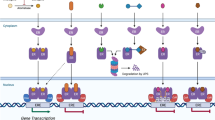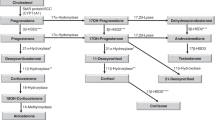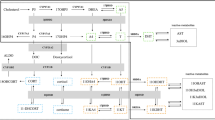Abstract
CLEAVAGE of the angular methyl group at carbon-10 of the testosterone molecule results in a compound that is much more potent than the parent as an œstrogen antagonist (unpublished work) and myotropic agent1, but not as an androgen1. Since 19-norprogesterone has been known as a potent progestational agent for some years2 and 18,19-dinor-testosterone has recently been synthesized by Dr. W. F. Johns, of the Division of Chemical Research, G. D. Searle and Co., these two materials have been examined as antagonists of cestrone-induced vaginal smear changes in spayed mice.
This is a preview of subscription content, access via your institution
Access options
Subscribe to this journal
Receive 51 print issues and online access
$199.00 per year
only $3.90 per issue
Buy this article
- Purchase on SpringerLink
- Instant access to full article PDF
Prices may be subject to local taxes which are calculated during checkout
Similar content being viewed by others
References
Hershberger, L. G., Shipley, E. G., and Meyer, R. H., Proc. Soc. Exp. Biol. and Med., 83, 175 (1953).
Allen, W. M., and Ehrenstein, M., Science, 100, 251 (1944).
Biggers, J. D., and Claringbold, P. J., J. Endocrinol., 11, 277 (1954).
Author information
Authors and Affiliations
Rights and permissions
About this article
Cite this article
EDGREN, R. Œstrogen Antagonisms: 19-Norprogesterone and 18,19-Dinortestosterone as Œstrone Antagonists. Nature 190, 353 (1961). https://doi.org/10.1038/190353a0
Issue date:
DOI: https://doi.org/10.1038/190353a0



